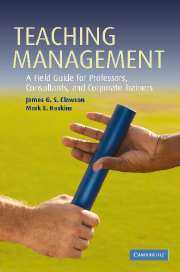Book contents
- Frontmatter
- Contents
- List of figures
- Sources to chapter quotations
- Why this book on teaching management?
- 1 Fundamental elements in teaching
- 2 Levels of learning: one, two, and three
- 3 Adult learning theory: it matters
- 4 Planning a course: trips and tips
- 5 Planning a class: no detail is too small
- 6 Lecturing: the possibilities and the perils
- 7 Managing discussions
- 8 Case method: fostering multidimensional learning
- 9 Role-playing
- 10 Case writing: crafting a vehicle of interest and impact
- 11 Case teaching notes: getting from here to there
- 12 Action learning
- 13 Experiential methods
- 14 Enhancing the conversation: audiovisual tools and techniques
- 15 Executive education: contributing to organizational competitive advantage
- 16 Using technology to teach management
- 17 Counseling students
- 18 Evaluating students: the twin tasks of certification and development
- 19 Teaching evaluations: feedback that can help and hurt
- 20 Research presentations
- 21 Managing a degree program: behind the ‘glory’
- 22 Managing a nondegree client program: an overview
- 23 Dealing with the press
- 24 Managing yourself and your time
- 25 Using teaching portfolios and course portfolios
- 26 Conclusion: is this on the exam?
- Index
20 - Research presentations
Published online by Cambridge University Press: 25 February 2010
- Frontmatter
- Contents
- List of figures
- Sources to chapter quotations
- Why this book on teaching management?
- 1 Fundamental elements in teaching
- 2 Levels of learning: one, two, and three
- 3 Adult learning theory: it matters
- 4 Planning a course: trips and tips
- 5 Planning a class: no detail is too small
- 6 Lecturing: the possibilities and the perils
- 7 Managing discussions
- 8 Case method: fostering multidimensional learning
- 9 Role-playing
- 10 Case writing: crafting a vehicle of interest and impact
- 11 Case teaching notes: getting from here to there
- 12 Action learning
- 13 Experiential methods
- 14 Enhancing the conversation: audiovisual tools and techniques
- 15 Executive education: contributing to organizational competitive advantage
- 16 Using technology to teach management
- 17 Counseling students
- 18 Evaluating students: the twin tasks of certification and development
- 19 Teaching evaluations: feedback that can help and hurt
- 20 Research presentations
- 21 Managing a degree program: behind the ‘glory’
- 22 Managing a nondegree client program: an overview
- 23 Dealing with the press
- 24 Managing yourself and your time
- 25 Using teaching portfolios and course portfolios
- 26 Conclusion: is this on the exam?
- Index
Summary
One stereotype of research is that it is a dispassionate process. The investigator is depicted as detached from the ideas, the methods, and the findings of the study he or she is conducting, as a neutral, unemotional actor in the scientific enterprise. We think the original dictum that gave rise to this distortion was intended to help minimize bias in the way a study was run, to steer the researcher away from forcing data to go the way he or she felt they should go to fulfill a preference. We believe that, over time, this has been translated, in some research method texts, seminars, and symposia, into an admonition against feelings as a component of the mature researcher's repertoire. If this were true, research would be a rather mechanistic and unimaginative endeavor.
– Peter Frost and Ralph Stablein, Doing Exemplary Research, p. 249Teaching professionals in a variety of roles often are called on to give presentations of their research. Whether as a scholar visiting another institution, making a presentation at the Academy of Management or another professional conference, or as a new graduate searching for a job, you can rest assured that the quality of your presentation can have a significant impact on your career. Many of us have sat through dry, dull, boring presentations about what ostensibly is the pride and passion of the presenter's professional life. It needn't be so. There are many things you can do to bring your research to life and make it more memorable and powerful in the minds of the listeners. If you clarify your purpose in giving the presentation, you will likely have a stronger foundation for beginning.
- Type
- Chapter
- Information
- Teaching ManagementA Field Guide for Professors, Consultants, and Corporate Trainers, pp. 371 - 377Publisher: Cambridge University PressPrint publication year: 2006



